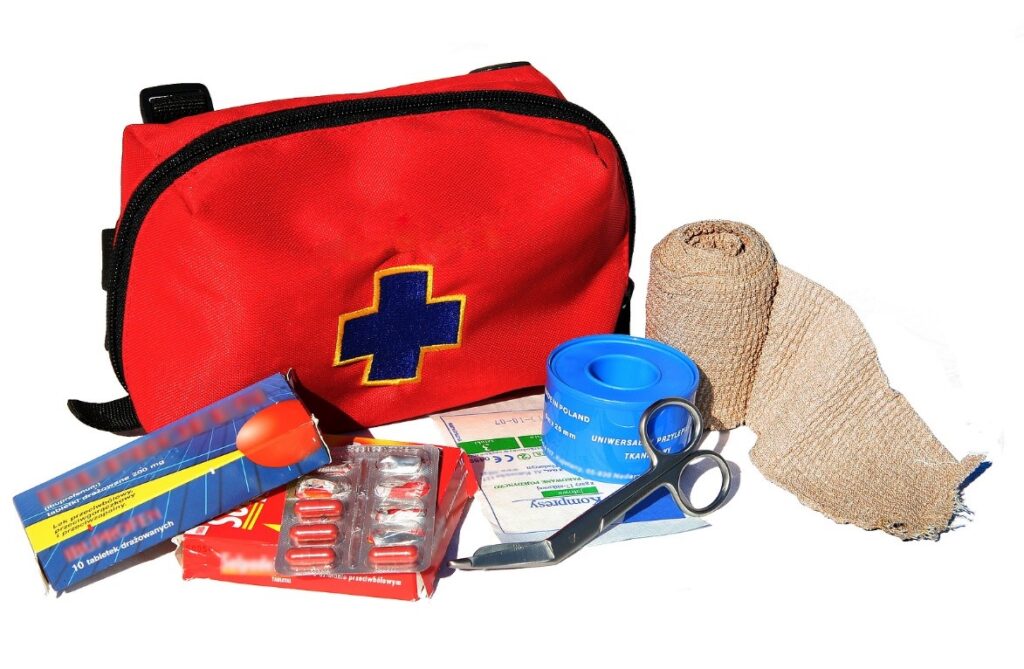Maintaining first-aid supplies at your home is an essential task. Every home should own a well-stocked first-aid kit that is easily accessible. Having the necessary supplies on hand ahead of time allows you to respond to a minor emergency quickly.
Creating a home first-aid kit is a reasonably simple task. You can create your first aid kit, or buy one from a pharmacy. If you decide to make one, choose large, sturdy, portable, and simple containers to open. Plastic boxes and containers are ideal for storing supplies because they are lightweight, have handles, have a lot of space, and have distinct compartments.
What Should Your Kit Contain?
According to the American College of Emergency Physicians, when you create a home first aid Kit it should include the following:
- Over-The-Counter Medicines:
Over-the-counter medicines can frequently help you manage the symptoms of headaches, muscle aches, itching, inflammation, and stomach aches. Some of the common ones are aspirin, ibuprofen, and acetaminophen. Speak with your medical provider if you have any concerns about the nature and safety of these medications for you or your child(ren)
- Drugs for Allergies:
It is essential to stock medicines specific to certain allergies. Stock antihistamine liquid, cream, or injectable epinephrine as directed by a physician (Epi-Pen or Twinject).
- Cold and Heat Packs:
Falling, bumps and bruises happen at home. If you don’t have any ice packs in your freezer (or if your power goes out and you can’t use your refrigerator or microwave), chemical instant heat and cold packs can come in handy.
- Calming Lotions:
These can be used to treat skin conditions like burns, itching, and dryness. Creams like calamine can reduce itch and irritation brought on by poison ivy and insect bites.
- Cold and Cough Medications:
Follow the label’s instructions. If you have concerns about using these medications for you or your child, consult your Doctor.
- Thermometer:
While a person’s “normal” body temperature can fluctuate slightly throughout the day, an unusually high temperature may indicate an infection or illness. By keeping a thermometer in a convenient location, you can check for fever in yourself or another family member and decide what to do next. (Moore)
- Creams Containing Hydrocortisone:
To alleviate rashes and irritation, keep creams with high hydrocortisone levels. Please remember that this cream has various strengths, so consult your Doctor about the best dosage. (Moore)
Additional Things to Keep In Mind:
- The date of purchase or packing should be written on the packaged goods.
- Keep an eye out for supplies with an expiration date or that have lost their potency over time.
- Ensure that the first aid kit contains an adequate number of bandages.
- Use resealable baggies or other water-tight containers to separate the dry or sterile items from anything that could leak or cause further damage.
- In your kit, include a piece of paper with the contact information for the family’s Doctor(s) or other emergency contacts.
- Include a small first-aid manual. You can also download first aid information for offline use.
- Add a bottle of water or bandages if your kit is used away from home.
- Vacuum-sealing can further protect the items that need to be kept dry if your kit will be used outdoors.
(American Red Cross)
Items for an Emergency
- Contact information for your family health care provider and pediatrician, local emergency services, emergency road service providers, and the poison helpline.
- Poison Control offers assistance in two ways in the United States: online at www.poison.org or by calling 1-800-222-1222. Both options are free, confidential, and available around the clock.
- Forms of medical consent for each family member
- Forms for each family member’s medical history
- Extra batteries and a small, waterproof flashlight or headlamp
- Space blanket for emergencies
- Solar-powered cell phone
- Repellent for insects
(Pitone)
It is best to regularly check your first-aid kits to ensure it is in good condition and that any items that have expired or been consumed have been replaced.
If you plan to visit Rice Emergency Room, please complete our online check-in process which you can find HERE
Medical questions can be answered by a physician on duty by calling: (281) 661-ADOC (2362)
Works Cited
“First-Aid Kit (for Parents) – Nemours Kidshealth.” Edited by Melanie L. Pitone, KidsHealth, The Nemours Foundation, June 2022, kidshealth.org/en/parents/firstaid-kit.html.
Mayo Clinic. “First-Aid Kits: Stock Supplies That Can Save Lives.” Mayo Clinic, Mayo Foundation for Medical Education and Research, 13 July 2022, www.mayoclinic.org/first-aid/first-aid-kits/basics/art-20056673
Moore, Jessica. “12 Items to Keep in Your Home’s First Aid Kit.” WebMD, WebMD, www.webmd.com/first-aid/features/tip-sheet-what-to-keep-in-your-first-aid-kit.
American Red Cross. “Make a First Aid Kit.” Supplies & Contents | American Red Cross, www.redcross.org/get-help/how-to-prepare-for-emergencies/anatomy-of-a-first-aid-kit.html.
 24x7 Available
24x7 Available

